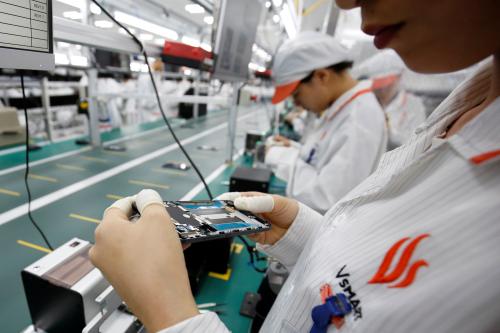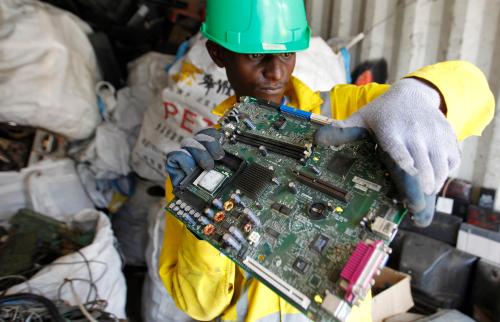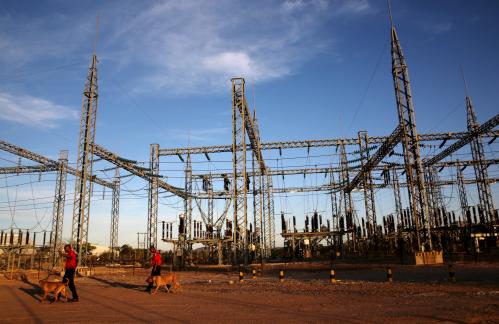Export diversification is strongly associated with economic growth and stability. But, what explains export diversification in developing countries? Answering this question is extremely difficult—to say the least—as many forces simultaneously shape the export basket of countries: costs of local labor and other inputs, trade partners, productivity trends, and laws and regulations, among others. In fact, what (and to whom) countries export has kept economists busy for centuries, starting with economist David Ricardo who in the 19th century came up with the idea of “comparative advantage”: countries export what they are comparatively good at to be able to import whatever they are comparatively worse at.
Becoming comparatively good at something, though, is a process evolving over time and is, in fact, path-dependent: a country’s comparative advantage tomorrow depends on its comparative advantage today. In other words, countries that export jeans might eventually also become an exporter of another “related” product in terms of its inputs or production process, such as khakis, for example. The dynamic process through which countries expand their export baskets into new products that are related to other existing exports has been extensively documented by economist Ricardo Hausmann and his co-authors at Harvard Center for International Development. Their measure of “relatedness” is geographic-based: if most countries that competitively export jeans also export khakis, then jeans and khakis are highly related. Yet, this measure is agnostic about the particular economic forces driving that relatedness. Are jeans and khakis related because their workers have similar skills? Or is it because they use similar technologies? Or are they related in terms of their position in the value chain?
In a recently completed working paper I, together with Ernesto Stein, Rodrigo Wagner, and Samuel Rosenow, explore this question. We use several competing measures of economic distance based on technology (measured through inter-industry patent citations), labor and skills (measured through worker flows between industries), and supplier and customer linkages (measured through input-output tables) to understand which are the strongest predictor of new exports.
Among our findings, one particular channel stands out in explaining diversification in developing countries: customer linkages. That is, exports are more likely to emerge if it is an input to an already existing competitive industry in the country. For example, a country is more likely to become a competitive exporter of fabric if it already exports jeans. In this example –you might ask—how were they making jeans before they became exporters of fabric? Perhaps they were producing fabric that was not competitive enough to be exported by itself and now is by having achieved higher production standards due to demand—or perhaps they were importing cheaper fabric from abroad and now, given demand, local suppliers appeared. On the other hand, the results for developed countries are, surprisingly, quite the reverse: the emergence of new sectors in rich countries is actually better explained by pre-existence of competitive suppliers.
Here is one possible interpretation of these results. Most developing countries have many incomplete markets and high levels of uncertainty, and thus the existence of a competitive industry that is a “potential buyer” can mitigate risks and expedite the process of development of new upstream sectors (e.g., inputs). In the presence of frictions in credit markets, for example, the mere existence of a local market for a product can reduce uncertainty both for the creditor and the investor. Our results generalize the evidence found by other economists that have looked at the role of firms inducing the productivity of their suppliers, in countries such as Lithuania and China. On the other hand, in developed countries where markets are more complete (and therefore risk is lower), capital is highly accessible and labor is expensive, what can really move the needle in terms of competitiveness is the availability of better (and cheaper) intermediate goods. In this case developed countries, which have export baskets that typically include sophisticated goods, are more likely to achieve competitiveness in new products if there is a local presence of highly productive intermediate goods markets necessary for the production of this new good.
This finding challenges the idea that developing countries should diversify by “adding value to their raw materials,” or in other words, that countries should expand their export baskets based on what outputs can be produced using the current production set as inputs. In fact, our results imply that while developing countries diversify “upward” in the value chain (e.g., inputs), developed countries diversify “downward” (i.e., outputs).
If indeed it is market completeness (or lack of it) driving these results, then there are some lessons useful for policymaking. In the presence of incomplete markets where the risks to start new ventures become too high for the private sector to absorb on its own, the government could play a role in mitigating those risks. After all, this is what many countries do to incentivize entrepreneurship. By providing loans on very generous conditions to entrepreneurs, the state is sharing or even absorbing the totality of the risk involved in the formation of new ventures, which potentially can develop into the emergence of sectors with latent comparative advantage.






Commentary
Purchase orders can get you a long way: export diversification in developed versus developing countries
June 27, 2017